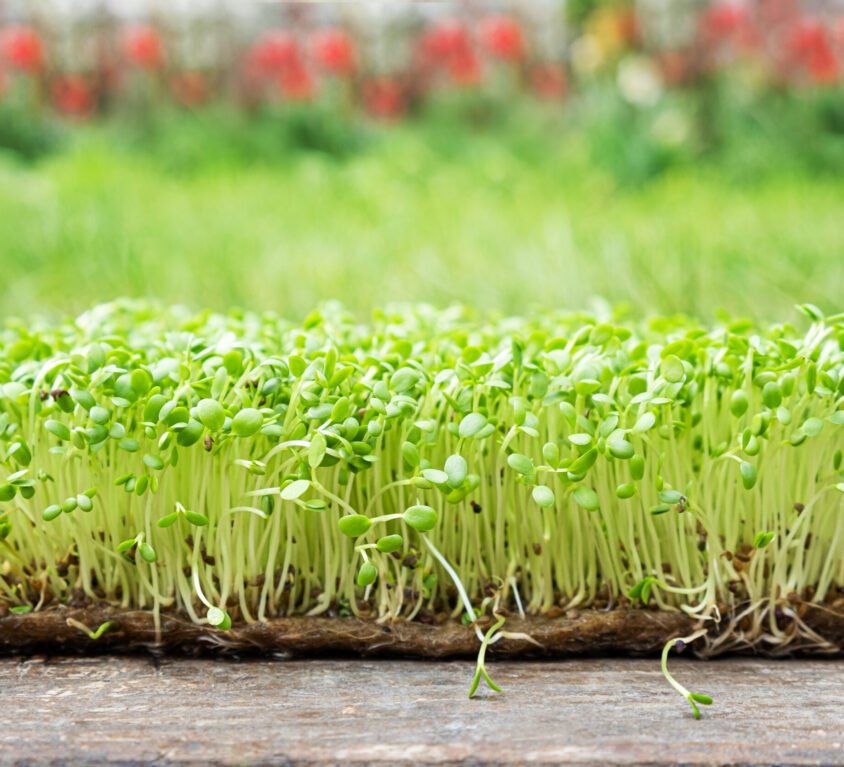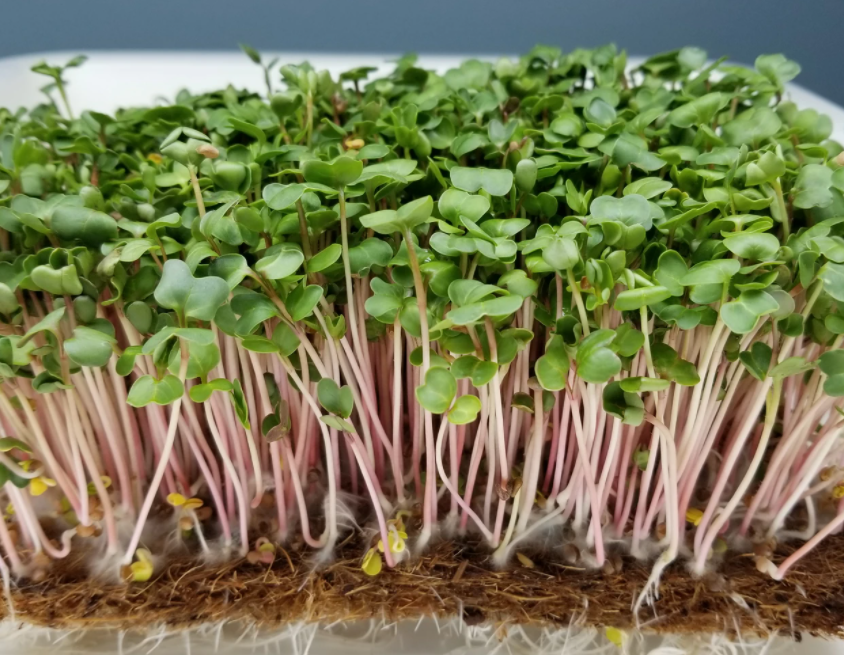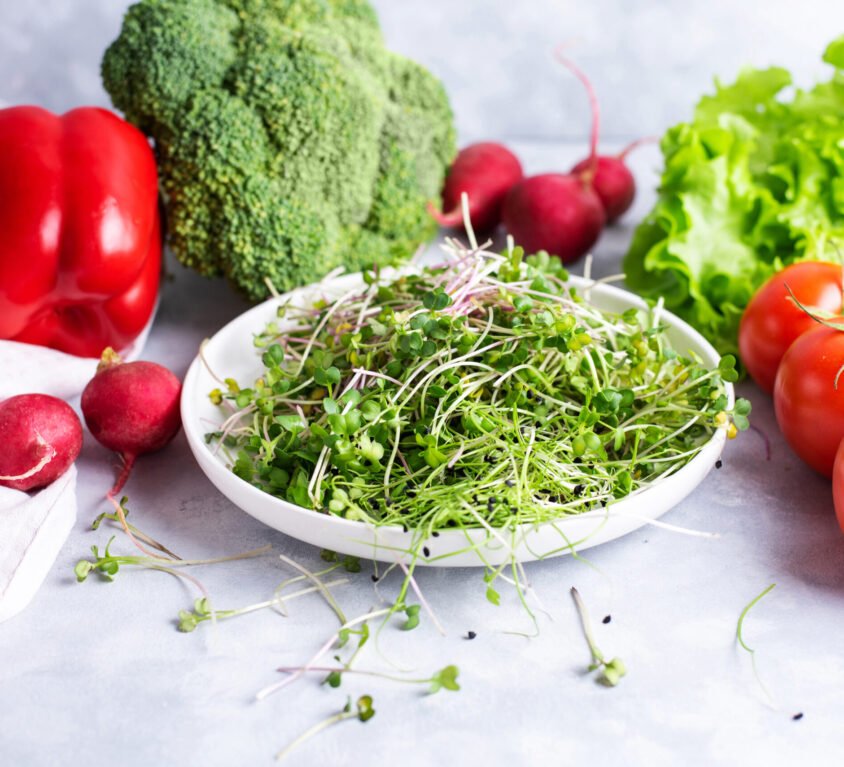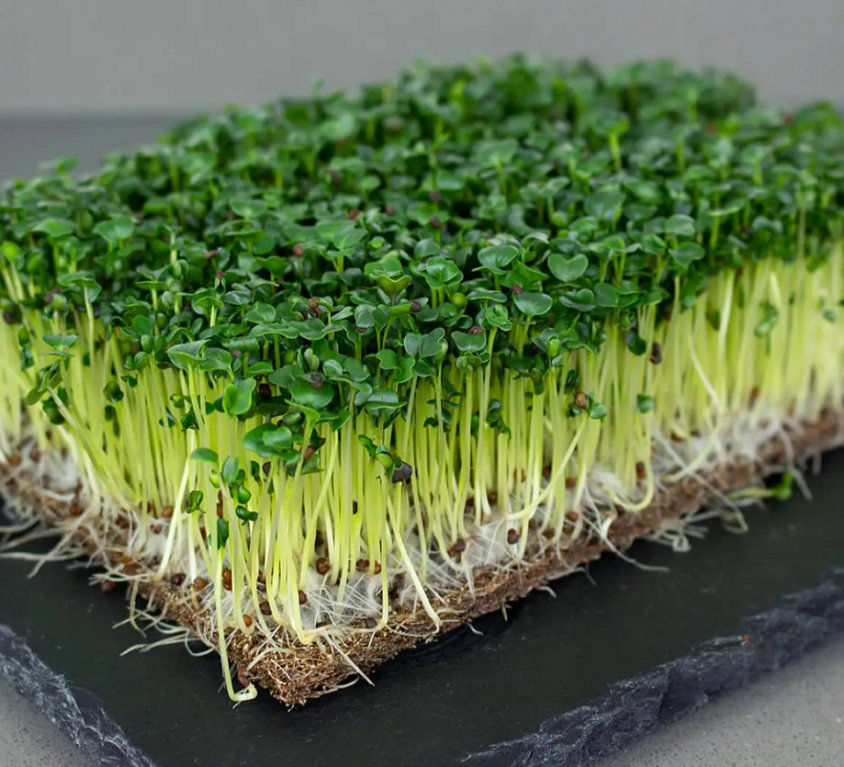Microgreens is the term people use to describe a plant that has been harvested after growing its first leaves. So from seed to first leaves, the plant only measures about 2 to 6 inches tall – that’s when it’s harvested and usually eaten within 1 day from harvest.
According to WebMD. Researchers have discovered that microgreens like red cabbage, radish, and cilantro contain up to 40 times more levels of vital nutrients than the mature version of the plant. Broccoli microgreens contain 100 times more sulforaphane than the fully grown version. Take everything that is good inside broccoli and jam it inside only a few leaves, then EAT it = Super Superfood.
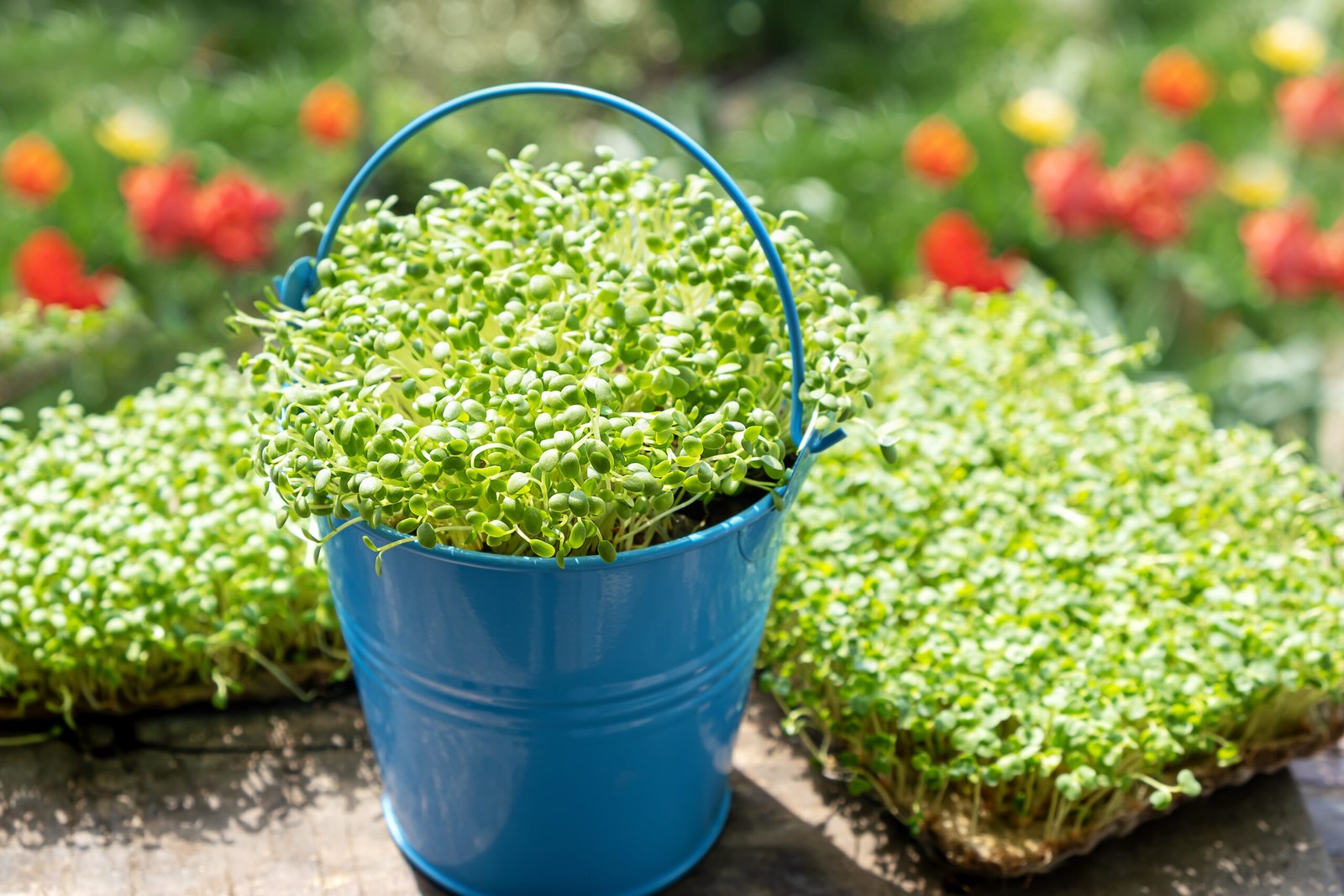
…ANY VEGETABLE YOU EAT CAN BE GROWN AND EATEN AT THE MICROGREEN STAGE…EXCEPT FOR NIGHTSHADES!
The biology behind microgreens
Microgreens have three basic parts: a central stem, cotyledon leaf or leaves, and typically, the first pair of very young true leaves.
They vary in size depending upon the specific variety grown, with the typical size being 1 to 1.5 in (25 to 38 mm) in total length. When the plant grows beyond this size, it should no longer be considered a microgreen.
Larger sizes have been called baby greens. The average crop-time for fast-growing microgreens, such as many brassicas, is 10–14 days from seeding to harvest. Slower growing microgreens, such as beets, chard, and many herbs, may take 16-25 days to reach harvestable size. Both baby greens and microgreens lack any legal definition. The terms “baby greens” and “microgreens” are marketing terms used to describe their respective categories.
Sprouts are germinated seeds and typically, are consumed as an entire plant (root, seed, and shoot), depending on the species. For example, sprouts from almond, pumpkin, and peanut reportedly have a preferred flavor when harvested prior to root developments. Sprouts are legally defined, and have additional regulations concerning their production and marketing due to their relatively high risk of microbial contamination compared to other greens.
Growers interested in producing sprouts for sale need to be aware of the risks and precautions summarized in the FDA publication Guidance for Industry: Reducing Microbial Food Safety Hazards for Sprouted Seeds (FDA 1999).
agnr rESEARCH CONFIRMS THE MICROGREEN SUPERFOOD THEORY
Researchers with the University of Maryland College of Agriculture and Natural Resources (AGNR) and the United States Department of Agriculture (USDA) recently completed a study to determine the level of nutrients in microgreens compared to their mature counterparts.
What are microgreens exactly? They are tiny, immature versions of vegetables, herbs and other plants harvested anywhere from a week to two weeks after germination that tend to be about one to two inches long with the stem and leaves still attached. Microgreens are typically only seen in fine dining restaurants, used as delicately placed garnishes or for a pop of unique flavor.
Assistant professor Qin Wang and graduate student Zhenlei Xiao with the College of AGNR’s Department of Nutrition and Food Science (NFSC) participated in the study, which looked at nutrients like Vitamin C, E, K and beta carotene found in 25 different types of microgreens including cilantro, celery, red cabbage, green basil and arugula.
Their research ultimately discovered that the microgreens contained four to 40 times more nutrients than their mature counterparts.
“We were really surprised,” Wang said of the findings, which were published in the Journal of Agricultural and Food Chemistry. “Those nutrients are very important to us. Vitamin C is considered an antioxidant, as well as Vitamin E, so they’re very important for us to consume.”
“Some of the numbers were really, really high,” said Xiao. “We thought it might have been a mistake but we double-checked so many times and there were no mistakes.”
It has long been speculated that microgreens packed a potent punch of antioxidants but until now, no research existed to support the theory. “There’s just no evidence,” said Wang. “That’s what motivates us to do this kind of research.”
Because microgreens are so delicate, they are not recommended for cooking and should be eaten raw with minor washing, says Wang. As a result, they only have a shelf life of two to five days and are difficult for the average consumer to come by.
“Production is low right now and the cost is high so they are really only used in upscale restaurants. They are really not available in the grocery store,” said Wang.
Wang, Xiao and USDA researchers also looked at ways to possibly increase production and lower the cost of microgreens by examining the effects of different temperatures, packaging techniques and washing conditions. The research team is currently testing how the tiny greens respond to various light exposures.
But before you dash out for a mega-dose of microgreens, Wang says more research needs to be done on different varieties of the tender veggies, of which there are many, as well as updated comparative research on their mature counterparts. While Xiao taste-tested all of the microgreens in the study and found most of them to be quite flavorful, particularly the young purple radish, she advises consumers to use moderation. “I would say adding it to your sandwich, soup or salad, it definitely will taste better than if you eat it alone,” Xiao said. “They are really good food enhancers.”
Results of the microgreens research project conducted by the University of Maryland and the USDA has garnered attention from several national media outlets including National Public Radio (NPR) and The Huffington Post.
Growing microgreens
Growing microgreens is relatively easy, but yet is filled with challenges, ranging from preventing and managing fungus or mould growth to provided the right nutrients and growing media to the plants for getting quality produce. Many small “backyard” growers have sprung up selling their greens at farmers markets or to restaurants. A shallow plastic container with drainage holes, such as a nursery flat or prepackaged-salad box, will facilitate sprouting and grow out on a small scale. However, for commercial scale growing, specific trays suited to growing and supporting microgreens better have to be used.
Growing and marketing high-quality microgreens commercially is much more difficult, but also shows potential for providing better quality produce under controlled and sterile environments and could provide local communities with better nutritional diversity at scale. Artificial lighting is not necessarily needed for growing microgreens, but is required for indoor commercial setups for growing them. Microgreens can grow under various lighting conditions, including under indirect natural light and grow lights, but some source of light is necessary for them to reach to their true leaf stage or just before the time of harvest. Different lighting conditions can change the flavors of the microgreens being grown. For instance, corn microgreens are sweet when grown in the dark, but become bitter when exposed to light due to photosynthesis processes taking place in the sprouting plants.
Nightshade family plants such as potatoes, tomatoes, eggplants, and peppers should not be grown and consumed as microgreens, since nightshade plant sprouts are poisonous. Nightshade plant sprouts contain toxic alkaloids such as solanine and tropanes, which can cause adverse symptoms in the digestive and nervous systems – so just don’t grow those!
what is the difference between a sprout and a microgreen?
Sprouts are germinated or partially germinated seeds. A sprout consists of the seed, root, stem, while microgreens are harvested without the roots.
Microgreens have stronger flavors compared to sprouts, and come in a wide selection of leaf shapes, textures, and colors.
Microgreens are grown in soil or soil-like materials such as peat moss. Microgreens require high light levels, preferably natural sunlight with low humidity and good air circulation. Microgreens are planted with very low seed density compared to sprout processing. Crop times are generally one to two weeks for most varieties, although some can take four to six weeks. Microgreens are ready to harvest when the cotyledons are fully expanded. Harvesting is usually with scissors cutting just above the soil surface, excluding any roots. Some growers sell them while still growing, rooted in the growing trays so that they may be cut later. Once removed from their growing environment, these trays of microgreens must be used quickly or they will rapidly begin to elongate and lose color and flavor.
Sprout seeds are soaked in water, usually for eight hours and then drained. A high density of seed is placed inside of sprouting equipment or enclosed containers. The seed germinates rapidly due to the high moisture and humidity levels maintained in the enclosures. Seeds can also be sprouted in cloth bags that are repeatedly soaked in water. The sprouting process occurs in dark or very low light conditions. After a few days of soaking and repeated rinsing in water (several times a day to minimize spoilage), the processing is complete and the sprouts are ready to consume.
The conditions that are ideal for properly grown microgreens do not encourage the growth of dangerous pathogens. These growing methods would not work for the production of sprouts.
However, the potential for food safety issues with microgreens may be increasing due to the number of indoor microgreen growing operations in which excessive seed density, low light intensity, low air circulation, or most commonly, a lack of GAP (good agricultural practices) and GMP (good manufacturing practices) based food safety procedures. Certain provisions of the Guidance for Industry: Reducing Microbial Food Safety Hazards For Sprouted Seeds may be beneficial and prudent for growers of microgreens to follow. Also, not all plants can be grown as microgreens due to toxicity concerns as mentioned before but worth mentioning again. For instance, nightshade plants (eggplants, tomatoes, potatoes, peppers, etc.) should not be grown as microgreen sprouts, since nightshade sprouts are toxic.
Microgreen Storage
Microgreens have a long shelf life if stored and packaged properly. Optimal methods of storing and transporting microgreens are currently being studied. Commercial microgreens are most often stored in plastic clamshell containers, which do not provide the right balance of oxygen and carbon dioxide for live greens to breathe. This is why microgreens are normally sold cut and packaged in a non breathable container.
When freshly cut the shelf life for microgreens can be several weeks. Some growers add a food safe moisture wicking material in the bottom of the container to extend shelf life. Moisture control and temperature are the two most important factors when considering the longevity of packaged microgreens and their transport. “After harvesting, microgreens should be kept as cool as possible without damaging the product.
Minimizing the time the product is left at room temperature should be a required practice. Microgreens should be stored in a clean, refrigerated area at 4°C or less to minimize microbial growth. A thermometer should be installed and monitored regularly in the temperature-controlled environment. Microgreens should also be stored in a manner that prevents product damage.
Stacking too many clamshell packages or bags of product on top of each other could cause damage to the product at the bottom of the stacks, which raises the risk of faster deterioration of the final product. While shelf life will vary from species to species and variety to variety, most microgreens will have a shelf life of approximately 5 to 10 days with proper handling and storage. The high level of care, attention and proper storage put into the product needs to be transferred into the distribution stages.
Microgreens need to be transported in refrigerated spaces to reduce risk of contamination and microbial growth. Although it is up to the end consumer to follow basic food safety requirements, growers should advise customers on the recommended handling and storage of the product when opportunity allows.
The ARS researchers found that buckwheat microgreens packaged in films with an oxygen transmission rate of 225 cubic centimeters per square inch per day had a fresher appearance and better cell membrane integrity than those packaged in other films tested. Following these steps, the team maintained acceptable buckwheat microgreen quality for more than fourteen days—a significant extension, according to authors. This study was published in LWT-Food Science and Technology in 2013.
Light-emitting diodes, otherwise known as LEDs, now provide the ability to measure impacts of narrow-band wavelengths of light on seedling physiology. The carotenoid zeaxanthin has been hypothesized to be a blue light receptor in plant physiology. A study was carried out to measure the impact of short-duration blue light on phytochemical compounds, which impart the nutritional quality of sprouting broccoli microgreens. Broccoli microgreens were grown in a controlled environment under LEDs using growing pads. Short-duration blue light acted to increase important phytochemical compounds influencing the nutritional value of broccoli microgreens.
From humble beginnings to a delicious and powerful superfood. Watch the 4 minute video of 4 different microgreens as they go through the various stages of growth. From germination, to sprouting to producing its first true leaves. A beautiful process.


